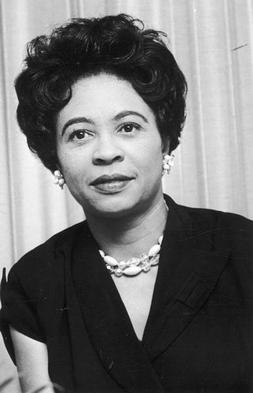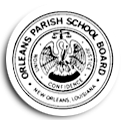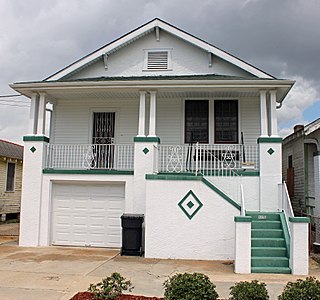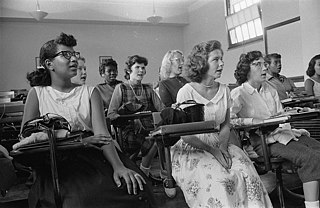Related Research Articles

Desegregation busing was an attempt to diversify the racial make-up of schools in the United States by sending students to school districts other than their own. While the 1954 U.S. Supreme Court landmark decision in Brown v. Board of Education declared racial segregation in public schools unconstitutional, many American schools continued to remain largely racially homogeneous. In an effort to address the ongoing de facto segregation in schools, the 1971 Supreme Court decision, Swann v. Charlotte-Mecklenburg Board of Education, ruled that the federal courts could use busing as a further integration tool to achieve racial balance.

Daisy Bates was an American civil rights activist, publisher, journalist, and lecturer who played a leading role in the Little Rock Integration Crisis of 1957.

Ruby Nell Bridges Hall is an American civil rights activist. She was the first African American child to attend formerly whites-only William Frantz Elementary School in Louisiana during the New Orleans school desegregation crisis on November 14, 1960. She is the subject of a 1964 painting, The Problem We All Live With, by Norman Rockwell.

Massive resistance was a political strategy created by American politicians Harry F. Byrd and James M. Thomson aimed at getting Virginia officials to pass laws and policies preventing public school desegregation, particularly after Brown v. Board of Education. Many schools and an entire school system were shut down in 1958 and 1959 in attempts to block integration.

Vivian Juanita Malone Jones was one of the first two black students to enroll at the University of Alabama in 1963, and in 1965 became the university's first black graduate. She was made famous when George Wallace, the Governor of Alabama, attempted to block her and James Hood from enrolling at the all-white university.

The Orleans Parish School Board (OPSB), branded as NOLA Public Schools, governs the public school system that serves New Orleans, Louisiana. It includes the entirety of Orleans Parish, coterminous with the city of New Orleans.

The McDonogh Three is a nickname for three African American students who desegregated McDonogh 19 Elementary School, in New Orleans on November 14, 1960. Even though school segregation had been illegal since the Brown v. Board of Education decision in 1954, no states in the American Deep South had taken action to integrate their schools.

The McDonogh Day Boycott on 7 May 1954 was a protest by African American public school students, teachers, and principals in New Orleans. It was one of the city's first organized civil rights protests.

Alexander Pierre "A. P." Tureaud Sr. was an African-American attorney who headed the legal team for the New Orleans chapter of the NAACP during the Civil Rights Movement. With the assistance of Thurgood Marshall and Robert Carter from the NAACP Legal Defense and Educational Fund, A. P. Tureaud filed the lawsuit that successfully ended the system of Jim Crow segregation in New Orleans. That case paved the way for integrating the first two elementary schools in the Deep South.
Ruby Bridges is a 1998 television film, written by Toni Ann Johnson, directed by Euzhan Palcy and based on the true story of Ruby Bridges, one of the first black students to attend integrated schools in New Orleans, Louisiana, in 1960. As a six-year-old, Bridges was one of four black first-graders, selected on the basis of test scores, to attend previously all-white public schools in New Orleans. Three students were sent to McDonogh 19, and Ruby was the only black child to be sent to William Frantz Elementary School. It is currently available for streaming on Disney+.
Public schools in New Orleans, Louisiana, were desegregated to a significant degree for a period of almost seven years during the Reconstruction Era following the Civil War of the United States. Desegregation of this scale was not seen again in the Southern United States until after the 1954 federal court ruling Brown v. Board of Education established that segregated facilities were unconstitutional.

The New Orleans Branch is the oldest continuously active branch of the National Association for the Advancement of Colored People south of Washington D.C. It was formally chartered on July 15, 1915. However, prior to that time, there had been organizational efforts underway to affiliate with this new national civil rights organization which had first organized in New York City in 1909. In 1911, Emanuel M. Dunn, Paul Landix Sr. and James E. Gayle wrote to the NAACP national office to obtain more information about this "new abolition movement." Apparently, the locals did not wait for formal action from the national office, but proceeded to organize without official sanction.

John McDonogh Senior High School was a public charter high school located in the Mid-City neighborhood of New Orleans, Louisiana, United States. The school was named after John McDonogh.

The Problem We All Live With is a 1964 painting by Norman Rockwell that is considered an iconic image of the Civil Rights Movement in the United States. It depicts Ruby Bridges, a six-year-old African-American girl, on her way to William Frantz Elementary School, an all-white public school, on November 14, 1960, during the New Orleans school desegregation crisis. Because of threats of violence against her, she is escorted by four deputy U.S. marshals; the painting is framed so that the marshals' heads are cropped at the shoulders, making Bridges the only person fully visible. On the wall behind her are written the racial slur "nigger" and the letters "KKK"; a smashed and splattered tomato thrown against the wall is also visible. The white protesters are not visible, as the viewer is looking at the scene from their point of view. The painting is oil on canvas and measures 36 inches (91 cm) high by 58 inches (150 cm) wide.

William Frantz Elementary School is an American elementary school located at 3811 North Galvez Street, New Orleans, Louisiana, 70117. Along with McDonogh No. 19 Elementary School, it was involved in the New Orleans school desegregation crisis during 1960.

School segregation in the United States was the segregation of students in educational facilities based on their race and ethnicity. While not prohibited from having or attending schools, various minorities were barred from most schools that admitted white students. Segregation was enforced legally in the U.S. states, primarily in the Southern United States, although segregation could occur in informal settings or through social expectations and norms. Segregation laws were met with resistance by Civil Rights activists and began to be challenged in 1954 by cases brought before the U.S. Supreme Court. Segregation continued longstanding exclusionary policies in much of the Southern United States after the Civil War. Jim Crow laws codified segregation. These laws were influenced by the history of slavery and discrimination in the US. Secondary schools for African Americans in the South were called training schools instead of high schools in order to appease racist whites and focused on vocational education. School integration in the United States took place at different times in different areas and often met resistance. After the ruling of Brown v. Board of Education, which banned segregated school laws, school segregation took de facto form. School segregation declined rapidly during the late 1960s and early 1970s as the government became strict on schools' plans to combat segregation more effectively as a result of Green v. County School Board of New Kent County. Voluntary segregation by income appears to have increased since 1990. Racial segregation has either increased or stayed constant since 1990, depending on which definition of segregation is used. In general, definitions based on the amount of interaction between black and white students show increased racial segregation, while definitions based on the proportion of black and white students in different schools show racial segregation remaining approximately constant.

The New Orleans school desegregation crisis was a period of intense public resistance in New Orleans that followed the 1954 U.S. Supreme Court ruling in Brown v. Board of Education that racial segregation of public schools was unconstitutional. The conflict peaked when U.S. Circuit Judge J. Skelly Wright ordered desegregation in New Orleans to begin on November 14, 1960.

In the United States, school integration is the process of ending race-based segregation within American public and private schools. Racial segregation in schools existed throughout most of American history and remains an issue in contemporary education. During the Civil Rights Movement school integration became a priority, but since then de facto segregation has again become prevalent.
This is a timeline of the civil rights movement in the United States, a nonviolent mid-20th century freedom movement to gain legal equality and the enforcement of constitutional rights for people of color. The goals of the movement included securing equal protection under the law, ending legally institutionalized racial discrimination, and gaining equal access to public facilities, education reform, fair housing, and the ability to vote.

McDonogh 19 Elementary School is an American elementary school located at 5909 St. Claude Avenue in the Lower Ninth Ward of New Orleans, Louisiana. Along with William Frantz Elementary School, it was involved in the New Orleans school desegregation crisis during the early 1960s.
References
- ↑ Reckdahl, Katy (January 1, 2019). "As a 6-year-old, Leona Tate helped desegregate schools. Now she wants others to learn that history". The Hechinger Report. Retrieved April 11, 2024.
- ↑ "First Day of School, 1960, New Orleans". The Kitchen Sisters. November 9, 2017. Retrieved March 15, 2020.
- ↑ Reckdahl, Katy (February 3, 2019). "The Rocky History of Desegregation in New Orleans". The Week. Archived from the original on February 3, 2019. Retrieved April 11, 2024.